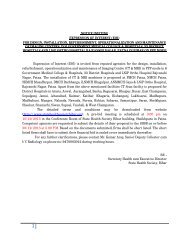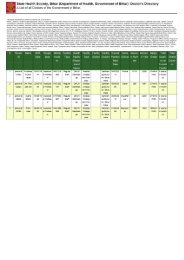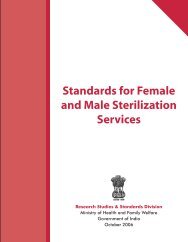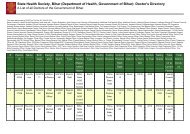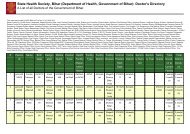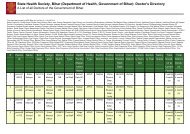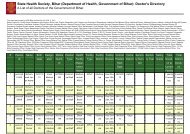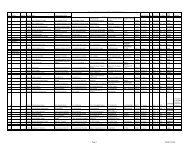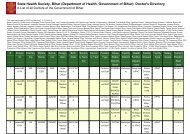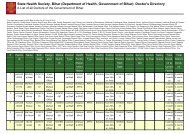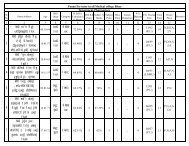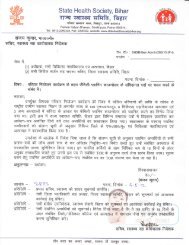Darbhanga - STATE HEALTH SOCIETY-----BIHAR
Darbhanga - STATE HEALTH SOCIETY-----BIHAR
Darbhanga - STATE HEALTH SOCIETY-----BIHAR
- No tags were found...
You also want an ePaper? Increase the reach of your titles
YUMPU automatically turns print PDFs into web optimized ePapers that Google loves.
,Ministry of Health and Family WelfareGovernment of IndiaDistrict Level Household and Facility Surveyunder Reproductive and Child Health Project (DLHS-3)District Fact Sheet 2007-08Bihar<strong>Darbhanga</strong>
For further information, please contact:Additional Director General (Stat.)Ministry of Health and Family WelfareGovernment of IndiaNirman BhavanNew Delhi - 110 011Telephone: 011-23061334Fax: 011-23061334E-mail: adg-mohfw@nic.inChief Director (Stat.)Ministry of Health and Family WelfareGovernment of IndiaNirman BhavanNew Delhi - 110 011Telephone: 011-23062699Fax: 011-23062699E-mail: cdstat@nic.inDirector/ Project Coordinator (DLHS -3)International Institute for Population Sciences (IIPS)Govandi Station Road, DeonarMumbai - 400 088Telephone: 022- 2556 3254/5/6Fax: 022- 2556 3257, 2555 5895E-mail: rchpro@iips.net, director@iips.netWebsite: http://www.rchiips.org
Bihar DLHS-3 District : <strong>Darbhanga</strong>About DLHS - 3:The District Level Household Survey (DLHS) was initiated in 1997 with a view to assess theutilization of services provided by government health care facilities and people’s perception aboutthe quality of services. The District Level Household Survey (DLHS -3) is the third in the series ofdistrict surveys, preceded by DLHS-1 in 1998-99 and DLHS-2 in 2002-04. As in DLHS-3, theInternational Institute for Population Sciences (IIPS) was the nodal agency to conduct DLHS-1 andDLHS-2. DLHS-3, like other two earlier rounds, is designed to provide estimates on importantindicators on maternal and child health, family planning and other reproductive health services. Inaddition, DLHS-3 provides information on important interventions of National Rural HealthMission (NRHM). Unlike other two rounds in which only currently married women age 15-44 yearswere interviewed, DLHS -3 interviewed ever-married women (age 15-49) and never married women(age 15-24).The sample size among the districts in the country varies according to their performance in terms ofAnte-Natal Care (ANC), institutional delivery, immunization, etc. and it was fixed based oninformation related to such indicators from DLHS-2. For low performing districts, 1500 Households(HHs), for medium performing districts, 1200 HHs and for good performing districts, 1000 HHswere fixed as sample size. In case of <strong>Darbhanga</strong>, sample size was 1200 households with 10%additional HHs to take care of non-response/refusal, etc.The survey used two-stage stratified random sampling in rural and three-stage stratified sampling inurban areas of each district. The information from 2001 Census was used as sampling frame forselecting primary sampling units (PSUs). In rural areas, all the villages in the district were stratifiedinto different strata based on population /HH size, percentage of SC/ST population, female literacy(7+), etc. The required number of villages from each strata was selected with probabilityproportional to size (PPS). In selected primary sampling units (villages), household listing was doneand required numbers of households were selected using systematic random sampling.For larger villages (more than 300 HHs) segmentation was carried out. In case of 300 to 600 HHs,two segments of equal size were made and one was selected using PPS. For PSUs having more than600 HHs, segments of 150 HHs were created depending on the size and then two segments wereselected using PPS. In case of urban areas, number of wards were selected using PPS at first stage.In a selected ward, one enumeration block from 2001 census was selected again using PPS.Procedure for segmentation, household selection, etc, was same as in the case of rural PSUs.The uniform bilingual questionnaires, both in English and in local language, were used in DLHS-3viz., Household, Ever Married Women (age 15-49), Unmarried Women (age 15-24), Village andHealth facility questionnaires.In the household questionnaire, information on all members of the household and the socioeconomiccharacteristics of the household, assets possessed, number of marriages to usual membersof the household since January 2004 and deaths in the household since January 2004etc. was collected. In case of female deaths, attempts were made to assess maternal death. Thehousehold questionnaire also collected information on respondent’s knowledge (seen/read/ heard)about messages related to various government health programmes being spread through media andother sources.1
Bihar DLHS-3 District : <strong>Darbhanga</strong>The ever married women's questionnaire consisted of sections on women's characteristics, maternalcare, immunization and child care, contraception and fertility preferences, reproductive healthincluding knowledge about HIV/AIDS.The unmarried women's questionnaire contained information on her characteristics, family lifeeducation and age at marriage, reproductive health-knowledge and awareness about contraception,HIV / AIDS, etc.The village questionnaire contained information on availability of health, education and otherfacilities in the village and whether the health facilities are accessible throughout the year.For the first time, population-linked facility survey has been conducted in DLHS-3. In a district, allCommunity Health Centres (CHCs) and District Hospital (DH) were covered. Further, all Subcentres(SC) and Primary Health Centres (PHC) which were expected to serve the population of theselected PSU were also covered. There were separate questionnaires for SC, PHC, CHC and DH.They broadly include questions on infrastructure, human resources, supply of drugs & instruments,and performance.Note:DLHS-2: information is based on data collected from currently married women 15-44 years.DLHS-3: information is based on data collected from ever married women 15-49 years.DLHS-2: In total percentage is adjusted for indicators considering over sampling of urban PSUs inDLHS-2. This adjustment is done in those districts where urban percentage is less than 30.DLHS-2: includes tap (inside residence/yard/plot), tap (shared/public), hand pump/borewell, wellcovered.DLHS-3: includes pipe into dwelling, piped to yard/plot, public tap/standpipe.Unmet need for spacingUnmet need for spacing includes the proportion of currently married women who are neither inmenopause or had hysterectomy nor are currently pregnant and who want more children after twoyears or later and are currently not using any family planning method. The women who are not sureabout whether and when to have next child are also included in unmet need for spacing.Unmet need for limitingUnmet need for limiting includes the proportion of currently married women who are neither inmenopause or had hysterectomy nor are currently pregnant and do not want any more children butare currently not using any family planning method.Unmet needUnmet need refers to unmet need for limiting and spacing.Correct knowledge of HIV/AIDSThe women who heard about HIV/AIDS and have correct knowledge about transmission ofHIV/AIDS and knowledge of prevention from HIV/AIDS.2
Bihar DLHS-3 District : <strong>Darbhanga</strong>District Indicators, <strong>Darbhanga</strong>, (2001 Census)Indicators Census 2001Population (in thousands) 3285Decadal Growth Rate (1991-01) 30.9Sex Ratio* 914Percent Urban population 8.1Percent SC population 14.6Percent ST population 0.01Female Literacy Rate (7 years and above) 30.4Male Literacy Rate (7 years and above) 57.2Sample outcome, DLHS -3, 2007-08Category No. covered Response RateHouseholds 1254 92.9Ever Married Women (15-49 years) 1119 88.6Unmarried Women (15-24 years) 199 89.6Sub Centres (SC) 37 100.0Primary Health Centres (P H C) 17 100.0Community Health Centres (C H C) 2 100.0District Hospital (D H) 1 100.0Population and Household Characteristics, 2007-08Background CharacteristicsDLHS - 3 DLHS - 2Total Rural Total RuralPercent total literate Population (Age 7 +) 56.5 54.7 - -Percent literate Male Population (Age 7 +) 71.1 70.4 - -Percent literate Female Population (Age 7 +) 43.0 40.6 - -Percent girls (age 6-11) attending Schools 98.5 98.3 - -Percent boys (age 6-11) attending Schools 99.4 99.7 - -Have Electricity connection (%) 25.4 21.7 10.5 6.4Have Access to toilet facility (%) 18.8 14.2 20.1 15.6Use piped drinking water (%) 0.2 0.1 18.7 18.1Use LPG for cooking (%) 5.5 1.8 8.2 3.8Live in a pucca house (%) 12.5 9.6 12.1 8.6Own a house (%) 98.1 98.3 - -Have a BPL card (%) 15.4 15.3 - -Own Agriculture Land (%) 29.1 30.7 - -Have a television (%) 9.7 6.6 13.8 9.9Have a mobile phone (%) 18.1 15.5 - -Have a Motorized Vehicle (%) 4.9 3.3 7.8 5.8Standard of Living IndexLow (%) 83.5 87.2 77.0 81.5Medium (%) 9.3 8.6 15.1 13.9High (%) 7.2 4.2 7.9 4.6* Number of Females per 1000 Males3
Bihar DLHS-3 District : <strong>Darbhanga</strong>IndicatorsMarriage and Fertility, (Jan 2004 to 2007-08)DLHS - 3 DLHS - 2Total Rural Total RuralPercentage of girl's marrying before completing 18 years 39.1 41.3 56.6 59.8Percentage of Births of Order 3 and above 51.4 51.8 57.3 57.8Sex Ratio at birth 107 105 - -Percentage of women age 20-24 reporting birth of order 2 & above 71.8 72.1 - -Percentage of births to women during age 15-19 out of total births 96.9 96.9 - -Family planning (currently married women, age 15-49)Current Use :Any Method (%) 31.8 30.4 28.9 27.7Any Modern method (%) 30.4 29.1 26.7 25.6Female Sterilization (%) 27.9 27.3 22.0 21.5Male Sterilization (%) 0.1 0.1 0.3 0.2IUD (%) 0.3 0.3 0.7 0.7Pill (%) 1.0 0.9 2.6 2.4Condom (%) 0.8 0.2 1.0 0.7Unmet Need for Family Planning:Total unmet need (%) 36.3 37.2 42.4 43.3For spacing (%) 14.7 15.2 17.5 18.2For limiting (%) 21.6 22.0 24.9 25.1Maternal Health:Mothers registered in the first trimester when they were pregnant with last livebirth/still birth (%)18.3 17.5 - -Mothers who had at least 3 Ante-Natal care visits during the last pregnancy (%) 29.0 28.1 12.6 10.4Mothers who got at least one TT injection when they were pregnant with theirlast live birth / still birth (%) # 71.9 71.0 24.7 22.1Institutional births (%) 15.1 14.2 12.5 10.2Delivery at home assisted by a doctor/nurse /LHV/ANM (%) 2.9 3.0 8.2 7.9Mothers who received post natal care within 48 hours of delivery of their lastchild (%)38.4 38.6 - -Child Immunization and Vitamin A supplementation:Children (12-23 months) fully immunized (BCG, 3 doses each of DPT, andPolio and Measles) (%)41.8 40.4 28.1 17.5Children (12-23 months) who have received BCG (%) 91.5 90.9 43.8 35.9Children (12-23 months) who have received 3 doses of Polio Vaccine (%) 52.5 51.3 40.8 27.2Children (12-23 months) who have received 3 doses of DPT Vaccine (%) 55.4 53.3 40.8 27.2Children (12-23 months) who have received Measles Vaccine (%) 56.8 56.9 29.2 19.4# It is adjusted according to DLHS-3 definition4
Bihar DLHS-3 District : <strong>Darbhanga</strong>IndicatorsChild Immunization and Vitamin A supplementation: (Contd...)DLHS - 3 DLHS – 2Total Rural Total RuralChildren (9-35 months) who have received at least one dose of Vitamin A (%) 63.0 63.2 - -Children (above 21 months) who have received three doses of Vitamin A (%) 2.9 2.4 - -Treatment of childhood diseases (children under 3 years based on last two surviving children)Children with Diarrhoea in the last two weeks who received ORS (%) 22.6 20.0 13.2 14.3Children with Diarrhoea in the last two weeks who were given treatment (%) 78.0 78.9 94.8 94.4Children with acute respiratory infection/fever in the last two weeks who were giventreatment (%)57.4 56.1 - -Children had check-up within 24 hours after delivery (based on last live birth) (%) 38.0 38.2 - -Children had check-up within 10 days after delivery (based on last live birth) (%) 38.4 38.6 - -Child feeding practices (Children under 3 years)Children breastfed within one hour of birth (%) 15.3 15.5 - -Children (age 6 months above) exclusively breastfed (%) 3.5 3.4 - -Children (6-24 months) who received solid or semisolid food and still being breastfed(%).78.4 77.7 - -Knowledge of HIV/AIDS and RTI/STI among Ever married Women (age 15-49)Women heard of HIV/AIDS (%) 29.4 27.0 32.5 29.8Women who knew that consistent condom use can reduce the chances of gettingHIV/AIDS (%)27.9 26.1 14.2 13.0Women having correct knowledge of HIV/ AIDS (%) 79.1 76.2 - -Women underwent test for detecting HIV/ AIDS (%) 2.2 1.4 - -Women heard of RTI/STI (%) 35.0 34.3 95.5 95.3Knowledge of HIV/AIDS among Un-married Women (age 15-24)Women heard of HIV/AIDS (%) 44.2 41.6 - -Women who knew that consistent condom use can reduce the chances of gettingHIV/AIDS (%)27.5 29.1 - -Women having correct knowledge of HIV/ AIDS (%) 80.6 77.6 - -Women underwent test for detecting HIV/ AIDS (%) 0.9 0.0 - -Women heard of RTI/STI (%) 14.5 14.4 - -Women facilitated/motivated by ASHA forAnte-natal Care (%) 6.1 6.4 - -Delivery at Health Facility (%) 3.9 4.2 - -Use of Family Planning Methods (%) 2.6 2.5 - -5
Bihar DLHS-3 District : <strong>Darbhanga</strong>Village (N=46)IndicatorsNumberVillages that have implemented Janani Suraksha Yojana (JSY) 43Villages with Health & Sanitation Committee 0Villages with Rogi Kalyan Samiti (RKS) 7Villages where PRI aware of untied fund by Government 0Health facility within village-ICDS (Anganwadi) 42If health facility is not in the village, whether accessible to the nearest health facility throughout the year-ICDS(Anganwadi)1Health facility within village- Sub-Centre 17If health facility is not in the village, whether accessible to the nearest health facility throughout the year-Sub-Centre15Health facility within village- PHC 2If health facility is not in the village, whether accessible to the nearest health facility throughout the year-PHC 27Health facility within village- Block PHC 0If health facility is not in the village, whether accessible to the nearest health facility throughout the year-BlockPHC25Health facility within village- Govt. Dispensary 0If health facility is not in the village, whether accessible to the nearest health facility throughout the year-Government. Dispensary16Health facility within village- Private Clinic 1If health facility is not in the village, whether accessible to the nearest health facility throughout the year-PrivateClinic28Health facility within village- AYUSH Health Facility 1If health facility is not in the village, whether accessible to the nearest health facility throughout the year-AYUSHHealth Facility24Facility SurveyIndicators Number Indicators NumberCommunity Health Centre (CHC) N = 2Infrastructure : Performance :CHC having Personal Computer 0 In-patients admission in last one month 340CHC having Operation Theatre 2 Referred cases for serious ailments from CHC 5to higher centre during last one monthCHC having Labour Room 2 Deliveries performed in last one month 311CHC having Blood Storage Facility 0 Blood transfusion done in last one month 0CHC having large deep freezer 1 Sterilization conducted in last one month 127CHC prepared a CHC plan for the current year 1CHC having water supply for 24 hours 0CHC having Ambulance on road 26
Bihar DLHS-3 District : <strong>Darbhanga</strong>Facility SurveyIndicators Number Indicators NumberCommunity Health Centre (CHC) (Contd...)Human Resource : Supply :CHC having General Surgeon 0 CHC with 24 hours normal delivery services 2CHC having Obstetrician/ Gynecologist 2 CHC with 24 hours New born care 1M.O. received training of Non-Scalpel Vasectomy(NSV) during last five yearsM.O. received training for Prevention, Care andSupport for HIV/AIDS during last five yearsM.O. received training of basic EmergencyObstetric Care during last five yearsM.O. received training of Integrated Managementof Neonatal and Childhood illness during last fiveyears2 CHC recognized as Integrated Counselingand Testing Centre (ICTC)3100Primary Health Centre (PHC) N= 17Infrastructure : Performance :PHC having Residential Quarter for MedicalOfficer11 Haemoglobin tests (TLC/DLC) conductedduring last one monthPHC having separate Labour Room 8 Blood smear examinations for malariaparasite conducted during last one monthPHC having Personal Computer 0 In-patient admissions during last one month 1,046PHC having Normal Delivery Kit 7 Referral cases for serious ailments from PHCto higher centres during last one monthPHC having Large Deep Freezer 4 Deliveries performed during last one month 1,345PHC having regular water supply 15 Beneficiaries of JSY during last one month 1,176PHC having Neonatal Warmer (Incubator) 0 Women provided with post-natal careservices during last one monthPHC having Operation Theater with BoylesApparatusPHC having Operation Theater with anaestheticmedicine0 New born care provided during last onemonth4 Infants and children immunized during lastone month0344691,2211,37210,364Condoms distributed during last one month 13,576PHC prepared the PHC plan for current year 167
Bihar DLHS-3 District : <strong>Darbhanga</strong>Facility SurveyIndicators Number Indicators NumberPrimary Health Centre (PHC) (Contd...)Human Resource : Supply :PHC having Lady Medical Officer (LMO) 6 PHC that received the untied fund inprevious financial yearPHC having Laboratory Technician 7PHC organized any training programme in theirPHC during last yearPHC having at least one MO, who receivedIntegrated Skill Development Training for 12days during last five yearsPHC having at least one MO, who receivedIMNCI training during last five years156611Sub Centre (SC) N = 37Infrastructure : Performance :Sub Centre located in government building 12 Number of Infants and children immunized 6,418Sub Centre having communication facility 0Sub Centre having separate labour room 0ANM staying in Sub Centre village 8Sub Centre having staff quarter for ANM 1Sub Centre having regular water supply 24Human Resource : Supply :Sub Centre where Male Health Worker inpositionANM had Integrated Skill Development Trainingin last 5 yearsANM ever been trained in Integrated SkillDevelopment TrainingANM trained in integrated management ofneonatal and childhood Illnesses (IMNCI) in last5 yearsANM ever been trained in integratedmanagement of neonatal and childhood Illnesses(IMNCI)ANM who attended Skilled birth attendant (SBA)training9 Sub-Centre having auto-disposable syringes 3413 Sub-Centre reporting IFA tablets out ofstock for more than 10 days during last onemonth23 Sub-Centre reporting Vitamin A out ofstock for more than 10 days during last onemonth10 Sub-Centre reporting ORS packets out ofstock for more than 10 days during last onemonth10 Sub-Centre that received untied fund inprevious financial year435153228
Bihar DLHS-3 District : <strong>Darbhanga</strong>Performance at a GlancePercentWomen had Minimum of Three Ante-natalCheck-up by Residence604029.028.120 12.6 10. 40TotalRuralPercentWomen Received At least One TT Injectionby Residence1008071. 971.06040 24.722.1200TotalRuralPercent806040200Contraceptive Use (Any Method) byResidence28.9 31.827.7 30.4TotalRuralDLHS-2DLHS-3DLHS-2DLHS-3DLHS-2DLHS-3Percent6040200Institutional Deliveries by Residence12.515.110.2TotalDLHS-2Rural14.2DLHS-3PercentPercent of Children (Age 12-23 Months)Received Measles Vaccine by Residence100806056.8 56.940 29.219.4200TotalRuralDLHS-2 DLHS-3PercentTotal100806040200Unmet Need for Family Planning byResidence42.4 43.336.3 37.2TotalDLHS-2RuralDLHS-39



